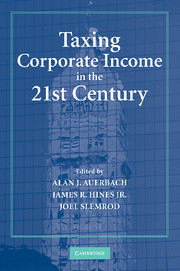Book contents
- Frontmatter
- Contents
- Contributors
- Preface
- 1 The Effects of Taxes on Market Responses to Dividend Announcements and Payments: What Can We Learn from the 2003 Dividend Tax Cut?
- Comments
- Comments
- 2 Dissecting Dividend Decisions: Some Clues about the Effects of Dividend Taxation from Recent UK Reforms
- Comments
- Comments
- 3 The 2003 Dividend Tax Cuts and the Value of the Firm: An Event Study
- Comments
- Comments
- 4 How Elastic Is the Corporate Income Tax Base?
- Comments
- Comments
- 5 An Empirical Examination of Corporate Tax Noncompliance
- Comments
- Comments
- 6 On the Extent, Growth, and Efficiency Consequences of State Business Tax Planning
- Comments
- Comments
- 7 Corporate Taxation and International Competition
- Comments
- Comments
- 8 The Changing Role of Auditors in Corporate Tax Planning
- Comments
- Comments
- 9 Taxation and the Evolution of Aggregate Corporate Ownership Concentration
- Comments
- Comments
- Index
- References
6 - On the Extent, Growth, and Efficiency Consequences of State Business Tax Planning
Published online by Cambridge University Press: 30 July 2009
- Frontmatter
- Contents
- Contributors
- Preface
- 1 The Effects of Taxes on Market Responses to Dividend Announcements and Payments: What Can We Learn from the 2003 Dividend Tax Cut?
- Comments
- Comments
- 2 Dissecting Dividend Decisions: Some Clues about the Effects of Dividend Taxation from Recent UK Reforms
- Comments
- Comments
- 3 The 2003 Dividend Tax Cuts and the Value of the Firm: An Event Study
- Comments
- Comments
- 4 How Elastic Is the Corporate Income Tax Base?
- Comments
- Comments
- 5 An Empirical Examination of Corporate Tax Noncompliance
- Comments
- Comments
- 6 On the Extent, Growth, and Efficiency Consequences of State Business Tax Planning
- Comments
- Comments
- 7 Corporate Taxation and International Competition
- Comments
- Comments
- 8 The Changing Role of Auditors in Corporate Tax Planning
- Comments
- Comments
- 9 Taxation and the Evolution of Aggregate Corporate Ownership Concentration
- Comments
- Comments
- Index
- References
Summary
Introduction
Traditionally, much of the literature on state corporate taxation has focused on how taxes affect the location of economic activity (see Wasylenko, 1997). A perpetual concern among policymakers is that higher tax rates or broader tax bases will retard regional economic development. In contrast, some recent research has begun to focus more on tax planning, or how firms expand after-tax profits by adjusting to tax policy through financial arrangements within related firms. Interest in tax planning among businesses is evidenced by the fact that each of the Big Four accounting firms and many banks maintain specific groups to deal exclusively with aiding firms in making arrangements to reduce their tax liability.
Tax planning is defined here as a broad set of tax avoidance and evasion schemes that affect only financial arrangements of firms. Tax planning is contrasted with strategies in which firms move physical operations to avoid higher taxes – herein termed locational distortions of tax policy. Firms may also respond to corporate taxation by altering the input mix or production technology, though no attempt is made here to measure the implications of this third effect. Tax planning exploits differences in state tax policies and often involves sophisticated arrangements wherein firms create one or more subsidiaries for the purpose of shifting income from high- to lower-tax jurisdictions. Tax planning strategies are often legal, but some may fall into a legally gray area or even be blatantly illegal methods of tax evasion, such as underreporting taxable income or overstating tax deductions.
- Type
- Chapter
- Information
- Taxing Corporate Income in the 21st Century , pp. 226 - 256Publisher: Cambridge University PressPrint publication year: 2007
References
- 11
- Cited by



